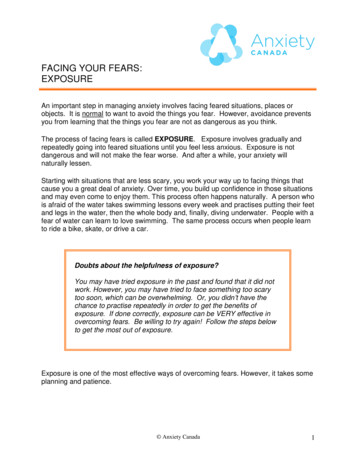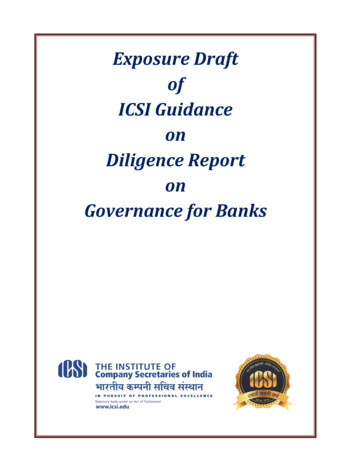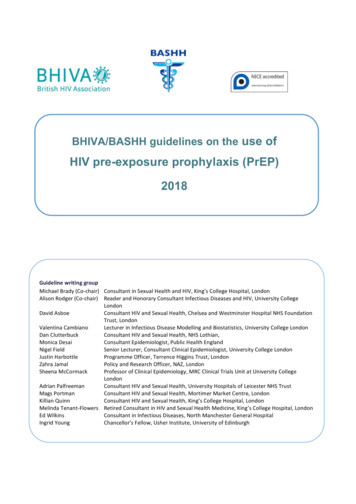
Transcription
FACING YOUR FEARS:EXPOSUREAn important step in managing anxiety involves facing feared situations, places orobjects. It is normal to want to avoid the things you fear. However, avoidance preventsyou from learning that the things you fear are not as dangerous as you think.The process of facing fears is called EXPOSURE. Exposure involves gradually andrepeatedly going into feared situations until you feel less anxious. Exposure is notdangerous and will not make the fear worse. And after a while, your anxiety willnaturally lessen.Starting with situations that are less scary, you work your way up to facing things thatcause you a great deal of anxiety. Over time, you build up confidence in those situationsand may even come to enjoy them. This process often happens naturally. A person whois afraid of the water takes swimming lessons every week and practises putting their feetand legs in the water, then the whole body and, finally, diving underwater. People with afear of water can learn to love swimming. The same process occurs when people learnto ride a bike, skate, or drive a car.Doubts about the helpfulness of exposure?You may have tried exposure in the past and found that it did notwork. However, you may have tried to face something too scarytoo soon, which can be overwhelming. Or, you didn’t have thechance to practise repeatedly in order to get the benefits ofexposure. If done correctly, exposure can be VERY effective inovercoming fears. Be willing to try again! Follow the steps belowto get the most out of exposure.Exposure is one of the most effective ways of overcoming fears. However, it takes someplanning and patience. Anxiety Canada1
How To Do ItSTEP 1. Make a listMake a list of situations, places or objects that you fear. For example, if you are afraid ofdogs, the list may include: looking at pictures of dogs; standing across the park from adog on a leash; standing in the same room as a dog on a leash; standing a few feet froma dog; or petting a puppy. If you are afraid of social situations, the list may include:saying “hi” to a co-worker; asking a stranger a question; making small talk with acashier; or calling a friend on the phone.HELPFUL HINT: Group Fears Together. Some people have a lot ofdifferent fears, so it can help to group similar fears or specific fear themestogether. For example, you may have a fear of bugs, as well as a fear ofheights. Make different lists for different fear themes.STEP 2. Build a Fear LadderOnce you have made a list, arrange things from the least scary to the most scary. Youcan do this by rating how much fear you have for each situation on the list, from “0” (Nofear) to “10” (Extreme fear). Once you have rated each situation, use the Fear Ladderform to make a final list.HELPFUL HINTS: When making a fear ladder, identify a specific goal(such as having a meal in a restaurant), and then list the steps needed toachieve that goal (e.g., go to a restaurant and get a coffee to go;have a coffee at the restaurant and sit near the door; have a snack at therestaurant and sit near the door; have a snack at the restaurant and sit at a tablein the middle of the room; have a meal at the restaurant and sit near the door;have a meal at the restaurant and sit in the middle of the room). See Examplesof Fear Ladders for some ideas on building your fear ladder.If you have a lot of different fears, build separate ladders for each fear theme.Each ladder should include a whole range of situations. The ladder shouldinclude some steps you can do now with mild anxiety, some that you can donow with moderate anxiety and, finally, the steps you find too difficult to donow. It is important to start really small and take gradual steps.Some steps on the ladder can be broken down into smaller steps. Forexample, if you are afraid to talk to co-workers, facing this situation could bebroken up into a number of steps such as saying “hi” to a co-worker, asking aquick question, and then talking about your weekend. Anxiety Canada2
Because it is sometimes difficult to come up with steps on the fear ladder thatcause only moderate anxiety (that is, somewhere between a little and veryscary), you can consider other factors that might make it easier or harder foryou to do.Some examples include:oLength of time: for example, talking to someone for 30 seconds isprobably less scary than talking for five minutes.oTime of day: for example, driving over a bridge in the middle of theafternoon versus evening rush hour.oEnvironment: for example, swimming at a local pool versus swimming ina lake.oWho is with you: for example, going to the mall with your spouse versusalone.See Examples of Fear Ladders for some ideasabout building your fear ladder.STEP 3. Facing fears (exposure)Starting with the situation that causes the least anxiety, repeatedly engage inthat activity (e.g., saying “hi” to the bus driver everyday) until you start to feelless anxious doing it. If the situation is one that you can remain in for aprolonged period of time (such as standing on a balcony), stay in thesituation long enough for your anxiety to lessen (e.g., standing on the balconyfor 20-30 minutes). If the situation is short in duration, try “looping” it, whichinvolves doing the same thing over and over again for a set number of times(e.g., repeatedly driving back and forth over a bridge until you start to feel lessanxious or making consecutive phone calls until you feel more comfortabledoing it).If you stay in a situation long enough (or continue engaging in a specificactivity), your anxiety will start to reduce. This is because anxiety takes a lotof energy and at some point it “runs out of gas”. The longer you facesomething, the more you get used to it and the less anxious you will feel whenyou face it again. Anxiety Canada3
HELPFUL HINT: It can help to track your fear level during exposureexercises and to try and remain in those situations (or continue engagingin a specific activity) until your fear level drops by about 50%. Forexample, if you rated holding a needle as a 6/10 on the fear scale(remember that “0” no fear and “10” extreme fear) then you want to continueholding the needle until your fear level drops to a 3/10.It is important to plan exposure exercises in advance; that way you feel morein control of the situation. Identify what you are going to do and when youplan to do it.Remember - Exposures should beplanned, prolonged, and repeated!Make sure to track your progress.See the Facing Fears form, whichwill help you identify how anxious you were before and after facing the fearedsituation, and what you learned. Make copies and fill one out each time youface a fear.Once you are able to enter a specific situation on several separate occasionswithout experiencing much anxiety you can move on to the next thing on thelist.KEY: Don’t Rush! It can be very scary facing the things you fear. Bepatient and take your time. Go at a pace that you can manage!Step 5. PractiseIt is important to practise on a regular basis. Some steps can be practiseddaily (e.g., driving over a bridge, taking an elevator, saying “hi” to a stranger,touching doorknobs), while other steps can only be done once in a while (e.g.,giving a formal presentation to a large group or taking a plane trip). However,the more often you practise the faster the fear will fade.Don’t forget to maintain the gains that you have made. Even if you havebecome comfortable doing something, it’s important to keep exposing yourselfto it from time to time, so your fears don’t creep back. For example, if youhave overcome a fear of needles, you should schedule routine blood tests ordonate blood every six months so that your fear of needles does not return.Re-rate your entire fear ladder every once in a while; that way, you can seethe progress you have made, and identify the steps on the ladder you stillneed to tackle. Anxiety Canada4
Remember, you will experience anxietywhen facing fears - this is normal.Step 6. Reward brave behaviourIt’s not easy facing fears. Reward yourself when you do it!It may be helpful to use specific rewards as a motivation to achieve a goal.For example, plan to purchase a special gift for yourself (DVD, CD, book,treat) or engage in a fun activity (rent a movie, go to the movies, go out forlunch or dinner, plan a relaxing evening) after you reach a goal.Don’t forget the power of positive self-talk (e.g., “I did it!”).TIP: Don't be discouraged if your fears start creeping back. This canhappen from time to time, especially during stressful periods or transitions(for example, starting a new job or moving). This is normal. It just meansthat you need to start practising using the tools – plan some exposures!Remember, coping with anxiety is a lifelong process.For more information on how to maintain your progress and how to cope with relapses insymptoms, see How to Prevent a Relapse . Anxiety Canada5
of Fear Ladders for some ideas on building your fear ladder. If you have a lot of different fears, build separate ladders for each fear theme. . For example, plan to purchase a special gift for yourself (DV











